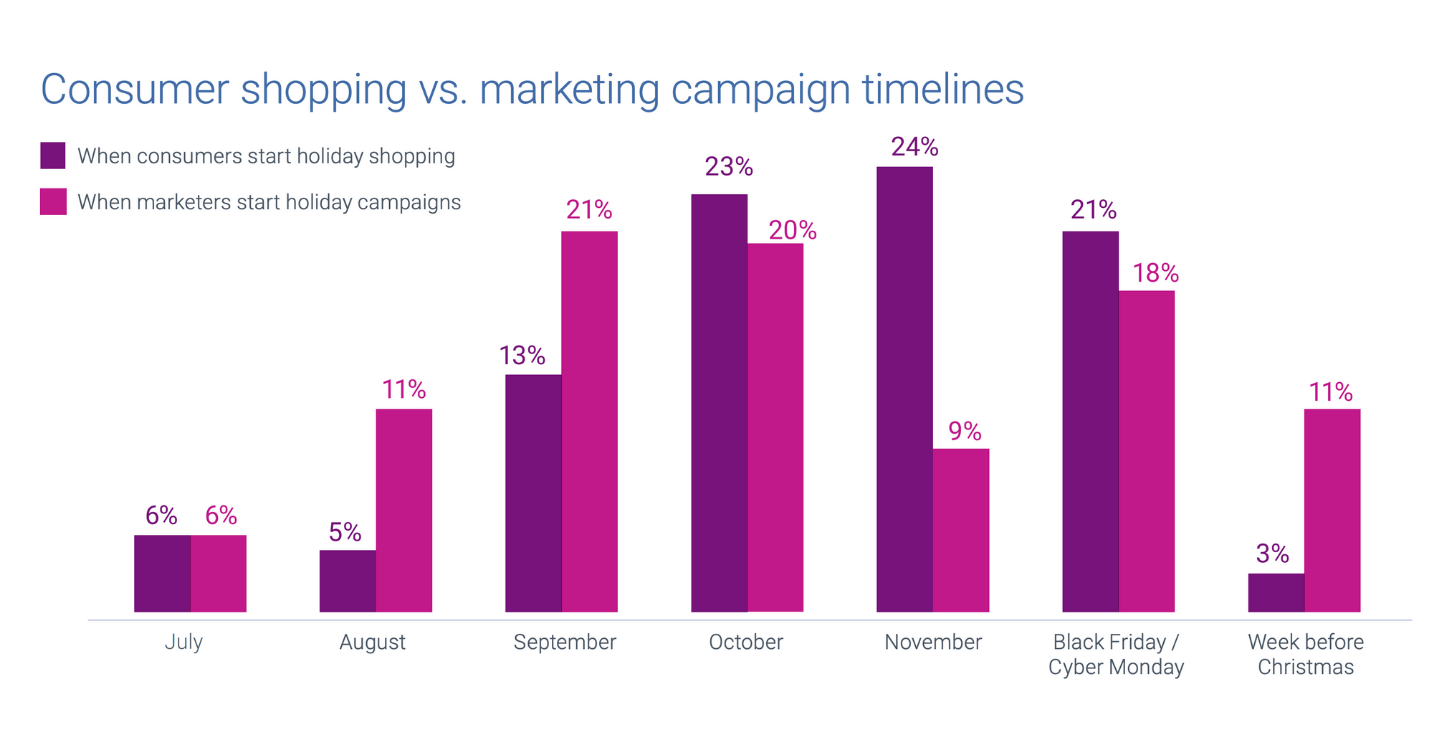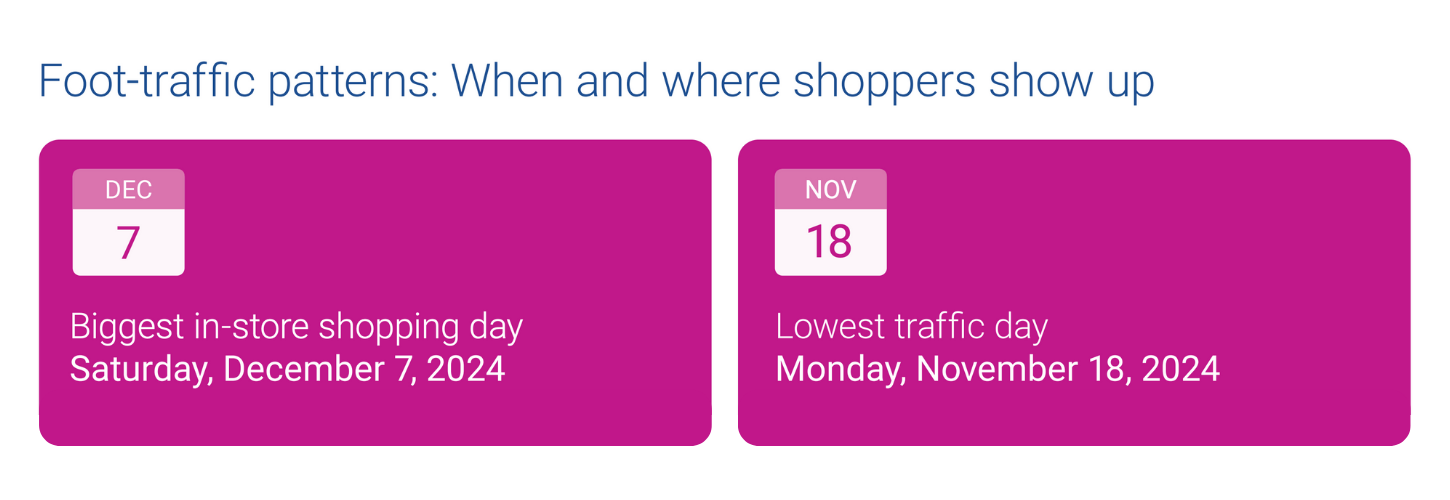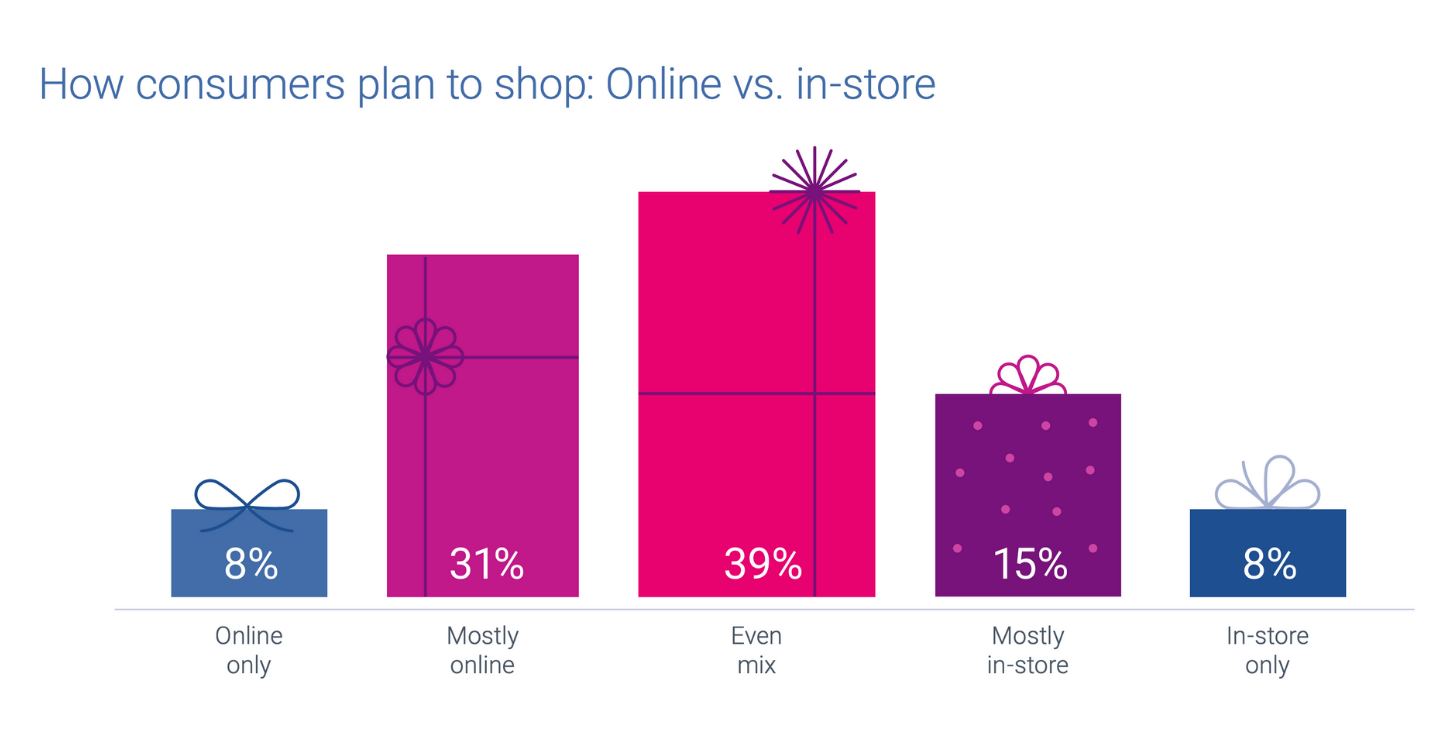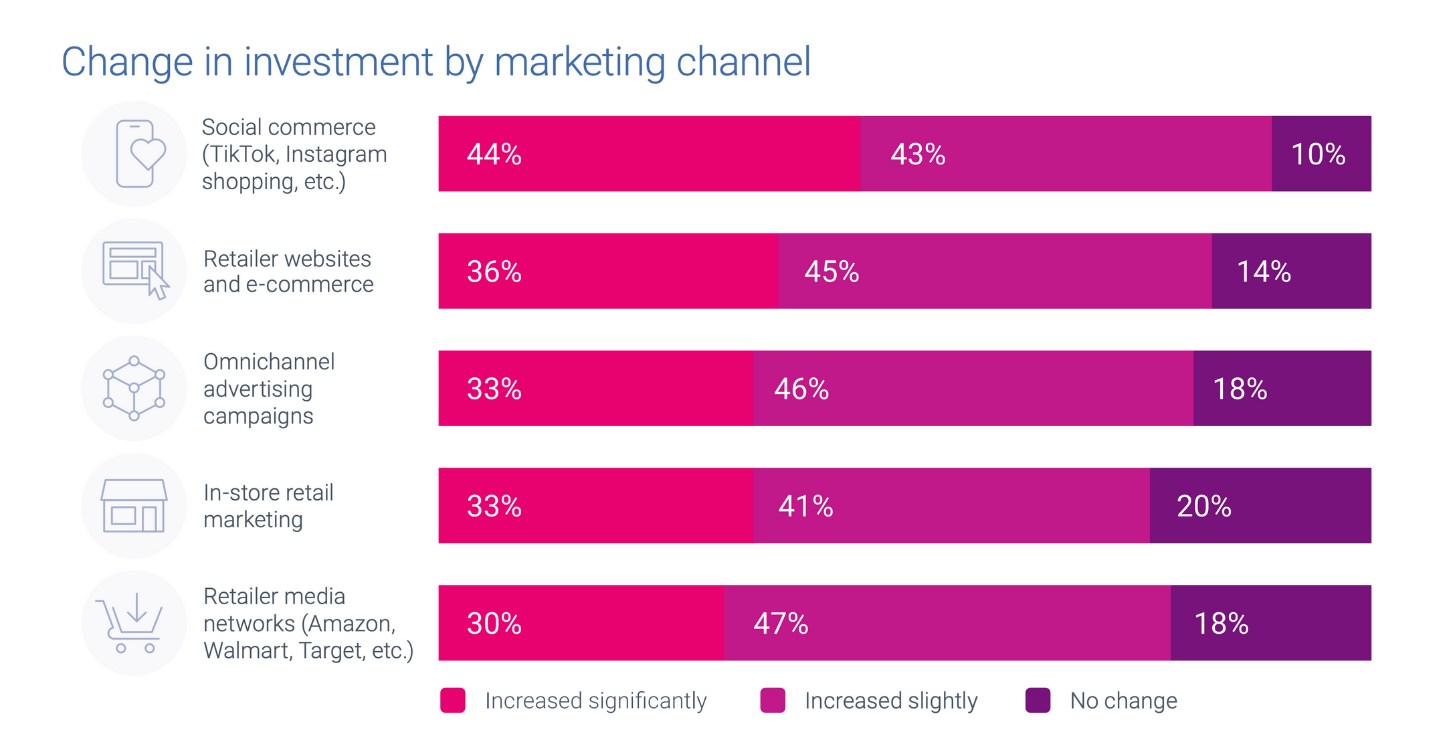At A Glance
Holiday shopping in 2025 doesn’t follow one clear pattern, with shoppers blending early planning and last-minute purchases, digital discovery and in-store validation, and cautious spending. Marketers who embrace this complexity, by staying relevant, consistent, and connected across channels, will be best positioned to win this season.Holiday shopping in 2025 feels a lot like a complicated relationship. Shoppers want deals, but they also want trust. They start shopping early, but they’re still browsing well into December. They love the convenience of online shopping, but they still show up in-store before making the final call.
Our 2025 Holiday spending trends and insights report, created this year in collaboration with GroundTruth, explores these contradictions. Our findings show that this year’s holiday season isn’t about one big shift; it’s about managing the push and pull between what consumers say, what they do, and how marketers respond.
Here are three complicated truths you need to know.
Experian’s 2025 Holiday spending trends and insights report
Optimize your 2025 holiday shopping campaigns with our latest report with GroundTruth.
Download now1. The new rules of holiday timing
Almost half (45%) of consumers plan to start shopping before November, but 62% admit they’ll still be buying in December. And post-holiday shopping (think gift card redemptions and deal-hunting) remains a real factor.


Why it’s complicated
The holiday calendar isn’t what it used to be. There’s no single “big moment” anymore. Instead, shoppers are spreading purchases across months, peaking around the “Turkey 12” (the 12 days surrounding Thanksgiving) and again in the final December rush.
What to do about it
- Stretch your campaigns across the full season, not just Cyber Week.
- Refresh offers to stay relevant as shopper motivations change from deal-seeking to last-minute urgency.
- Watch for post-holiday momentum and extend your promotions into January.
How belVita nailed the timing
In celebration of National Coffee Day, belVita partnered with GroundTruth on a one-month campaign to boost product awareness and drive foot traffic to Target stores. By utilizing digital out-of-home (DOOH) and mobile ads powered by location, behavioral, and purchase-based targeting, the campaign achieved a 3.44% visitation rate, nearly $476k in products added to carts, and a low cost-per-visit of just $0.22.
2. Online leads, but in-store still seals the deal
Nearly 40% of shoppers say they’ll split their purchases between online and in-store and 80% of consumers still prefer the in-store experience. Only a small fraction plan to shop exclusively in one channel. That means while digital often starts the journey, the final decision often happens in a physical store.

Why it’s complicated
Shoppers love the convenience of browsing online, but they still want the reassurance of seeing, touching, or testing products before buying. In-store isn’t just about the transaction, it’s the validation step.
What to do about it
- Build omnichannel strategies that connect digital discovery with in-store follow-through.
- Use location and identity data to tie digital impressions to real-world actions, like foot traffic and purchases.
- Focus on consistency: shoppers expect the same value, tone, and trust whether they’re on a website, in an app, or standing in a store aisle.
How Duke Cannon used on-premise targeting to drive sales lift
Duke Cannon, a premium men’s grooming brand, partnered with GroundTruth to launch a successful multichannel campaign utilizing location-based and behavioral audience targeting across CTV and mobile screens to drive in-store visits and sales.
By targeting consumers with mobile ads while they were physically in-store, the company capitalized on high purchase intent, aiding in the 12% sales lift. This strategic approach resulted in over 43.9k provable in-store visits and a significant increase in sales.
3. Marketers double down, consumers hold back
This holiday season, expectations are split. 66% of marketers expect holiday spend to rise, but only 22% of consumers agree. While brands are leaning into bigger investments across CTV, retail media, and social, shoppers are staying cautious, weighing value and waiting for the right deal.

Why it’s complicated
That disconnect introduces risk. If marketers don’t align spend with real consumer behavior, budgets can get wasted in the rush to cover every channel. Shoppers haven’t stopped spending, but they’re spending differently. They’re trading down to discount and big-box retailers while cutting back in discretionary categories like apparel and restaurants.
What to do about it
- Prioritize efficiency by focusing on the right audiences, not just more impressions.
- Make consistency your advantage: reach people once and connect across platforms instead of chasing fragmented signals.
- Balance aggressive media investment with messaging that acknowledges consumer caution — shoppers want value and trust, not hype.
Measuring TV and streaming impact with iSpot
iSpot’s Audience Builder, powered by Experian’s Marketing Attributes, helps brands reach high-value audiences. During the holiday season, a luxury retailer could target $100K+ households with affluent lifestyle interests. With iSpot’s Unified Measurement platform, they can track performance across linear TV and streaming and shift spend in real time to maximize results.
The bottom line on 2025 holiday shopping trends
This year’s holiday shopping season is, well…complicated. Shoppers are cautious but still engaged. They’re early planners and last-minute browsers. They want the ease of digital, but the confidence of in-person.
For marketers, the opportunity lies in embracing that complexity, not trying to simplify it away. The brands that balance relevance, trust, and convenience across the full season and across every channel will be the ones that win.
Download our full 2025 Holiday spending trends and insights report to explore all five shifts shaping this season and see how you can turn complexity into opportunity.
About the author

Fred Cheung
Director, Partnership Sales, Audigent, a part of Experian
Fred Cheung has spent over a decade in the programmatic advertising space, with roles at Mindshare, Jounce Media, Twitter, and The Trade Desk. His deep experience in trading and product management helps in his current function on the Experian Marketing Services’ Sales team where he focuses on data growth and adoption across the industries’ leading buy-side platforms.
2025 holiday shopping trends FAQs
Because consumer behavior is full of contradictions. People will shop earlier but also later, browse online but purchase in-store, and want deals while demanding trust. Marketers need to navigate these push-and-pull dynamics.
Nearly half (45%) say they’ll start before November, but 62% admit they’ll still be buying in December, with momentum even continuing into January through gift card redemptions and deal-hunting.
Although many consumers begin online, the majority still make their final decisions in-store. In-person shopping acts as a validation step where customers can see, touch, or try products before buying.
Instead of focusing only on Black Friday or Cyber Week, marketers should stretch campaigns across the full season, refresh offers frequently, and continue promotions into January.
Not entirely. 66% of marketers expect spending to rise, but only 22% of consumers agree. Shoppers are cautious, prioritizing value and often trading down to discount or big-box retailers.
An omnichannel approach using identity and location data can bridge digital impressions with real-world actions like store visits and purchases, ensuring consistency across touchpoints.
Brands like belVita and Duke Cannon successfully tied digital campaigns to in-store results by utilizing precise audience targeting, location data, and well-timed promotions.
You can download Experian’s 2025 Holiday spending trends and insights report to explore all five shifts shaping this season.
Latest posts

Connected TV (CTV) continues to expand as a dominant force in digital advertising. Streaming adoption is climbing, yet advertising budgets aren’t keeping pace. With the Newfronts and Upfronts presentations completed, advertisers are being asked to make big decisions with lingering questions still in the mix. One of the biggest barriers? Persistent misconceptions about what CTV can and can’t do. That uncertainty can hold teams back from putting serious weight behind the most addressable screen in the house. Experian works with leading CTV partners to tackle those concerns head on – whether it’s improving measurement, reducing wasted impressions, or making audience data more actionable. To help marketers walk into Upfront conversations with clarity and confidence, we connected with industry experts from Ampersand, the Advertising Research Foundation (ARF), FreeWheel, and Madhive to separate fact from fiction. Here are four common CTV myths – and the reality behind them 1. CTV is not ready for performance marketing Why this misconception exists CTV was once seen as a branding tool—good for awareness, but hard to measure. Without clear attribution or precise targeting, it wasn’t built for the kind of performance marketing advertisers expect from digital media. What's actually happening In the not-so-distant past, marketers lacked a consistent way to connect CTV impressions to digital or in-store actions because of device fragmentation and limited signal sharing between platforms. Today, you can reach specific audiences on the biggest screen in the house—and know what happened after they saw your ad. Advancements in identity resolution and cross-device tracking now allow advertisers to measure everything from incremental reach to store visits and purchases. The growing use of universal identifiers like Unified ID 2.0 (UID2) makes it easier to connect ad exposure to real outcomes across screens. "With better visibility into who’s watching CTV and what they do afterward, it’s no longer just about getting a message in front of people—we can actually understand if it drove real-world results, like a store visit or a purchase. By tapping into high-quality audience data—from behavioral to demographic to transactional—we’re able to improve match rates and reach, which ultimately leads to more meaningful outcomes for advertisers."Murphy Vandemotter, Director of Data Operations, Madhive That shift—from impressions to impact—is what makes CTV a true performance channel, not just a way to build brand awareness. How Madhive works with Experian to provide data that drives better targeting and measurement – at scale Madhive is helping local advertisers achieve better CTV outcomes by integrating Experian’s syndicated audiences directly into the Madhive Data Marketplace. Advertisers are using Experian’s data to better understand local audiences, deliver more personalized messaging, and extend campaign reach – in some cases, achieving 10x the reach compared to other marketplaces. Combined with Madhive’s measurement tools and real-time optimization capabilities, advertisers can maximize their CTV investments by building lookalike audiences, quickly adjusting underperforming strategies, and personalizing engagement with viewers at the local level. 2. CTV advertising lacks brand safety and fraud protection Why this misconception exists CTV is sometimes lumped in with the broader digital ecosystem, where concerns around fraud, brand safety, and opaque buying paths are more common. Some advertisers worry they’re not getting what they paid for—or worse, that their ads could appear next to low-quality content. What's actually happening CTV has a much stronger foundation for brand safety and ad fraud than many marketers realize. The most effective way to minimize risk is to work directly with premium publishers and their primary technology platforms — not through long, complex chains of intermediaries that can open the door to fraud and low-quality placements. Platforms like FreeWheel provide direct access to premium CTV inventory across major broadcast and cable brands, helping marketers consolidate spend and significantly reduce exposure to risk. Working with primary supply partners ensures ads run alongside trusted, high-quality programming, not questionable or low-value content. By prioritizing direct paths to premium publishers, advertisers can take greater control over where their campaigns appear, achieving better transparency, higher quality, and stronger outcomes. "Advertisers can reach a broad collection of premium CTV inventory directly through FreeWheel. This not only greatly reduces a marketer’s risk, but it also provides certainty that they’re getting what they paid for in terms of quality content to appear alongside their brands.” Matt Clark, VP of Strategic Partnerships, FreeWheel In other words, cutting corners often increases risk—while consolidation and direct access to premium supply creates a cleaner, safer media buy. How Experian and FreeWheel match quality content with quality targeting Industry standards like OpenRTB 2.6 are evolving to give advertisers more control over where and how their ads appear. At the same time, Experian is helping advertisers maximize that control through our integration with FreeWheel. Advertisers can access Experian’s syndicated audiences directly within FreeWheel’s sell and buy-side programmatic advertising platforms. This gives advertisers the ability to create and activate campaigns across linear, digital, and advanced TV. Backed by a deep understanding of people in the offline and digital worlds, Experian’s data is ranked #1 in accuracy by Truthset, giving advertisers confidence that they are reaching the right people. Television audiences you can reach include cord-cutters and consumers who subscribe to free and paid ad-supported streaming TV services. 3. CTV audiences are too fragmented to manage effectively Why this misconception exists With so many streaming platforms and devices in play, US households subscribe to 4 paid video streaming services on average, it can feel nearly impossible to manage reach and frequency without overspending or annoying your audience. What's actually happening Advertisers don’t need to choose between scale and precision anymore. With the right audience and identity strategy, it’s possible to connect the dots across screens and unify fragmented viewing behaviors. “We activate first- and third-party data across CTV, linear, and video-on-demand in a consistent way—making sure campaigns reach real households, not just devices. We also track unduplicated reach and frequency across platforms, so advertisers can understand what’s actually working. Together with Experian, we can measure whether those impressions moved the needle and guide media planning with full-funnel attribution insights."Anastasia Dukes-Asuen, Sr. Director of Advanced TV Data & Insights, Ampersand Experian Audiences are built on our household-level identity graph, giving advertisers a powerful tool to manage reach and frequency across screens. How Ampersand works with Experian Ampersand utilizes Experian Marketing Data to enhance audience-based media planning, activation, and optimization across linear and addressable TV platforms. By combining Experian Audiences with a footprint of 64 million data-enabled homes, Ampersand helps advertisers find the most valuable networks and dayparts to reach their intended viewers. Through its Addressable Simulator tool, powered by Experian data, Ampersand models different budget scenarios to show how reallocating spend into addressable TV can extend reach and improve efficiency. Using Experian-powered targeting has delivered real-world results, like helping a national cruise brand achieve a 14% lift in incremental reach, a 3.1x increase in frequency, and a 24% lower effective CPM. 4. CTV is only for younger, tech-savvy audiences Why this misconception exists Streaming was originally associated with younger viewers, leading advertisers to believe CTV wasn’t an effective way to reach older demographics. That impression stuck, but it’s no longer true. What's actually happening Smart TVs are everywhere, and CTV has gone mainstream. Across generations, households are tuning in to ad-supported streaming services in record numbers—and they’re doing it on the biggest screens in their homes. What ARF data shows New research from the Advertising Research Foundation (ARF) backs this up. According to the 2024 DASH TV Universe Study: 77% of U.S. households own at least one Smart TV 82% receive at least one ad-supported streaming service 62% of households receive at least one ad-supported subscription streaming service (AVOD) like Netflix or Max with ads “The audience with the highest Smart TV and ad-supported CTV adoption? Millennials and Gen Xers—Americans in their prime parenting years. Even Boomers have embraced CTV: 73% own a Smart TV and 72% receive at least one ad-supported CTV service.” Jim Meyer, General Manager of the Advertising Research Foundation (ARF) DASH TV Universe Study ARF and Experian gives marketers the most accurate understanding of who is watching We partnered with the ARF and its DASH universe study to create 18 TV audiences. By combining the ARF’s DASH data set with Experian Marketing Data, we developed one-of-a-kind TV audiences that reflect how viewers interact with digital devices and e-commerce accounts. We created this resource so our customers can align their marketing campaigns with media usage. These audience segments also yield insights that help marketers reach their audiences with the right messages and content. Make CTV work for you this Upfront season CTV is evolving fast, and advertisers who rely on outdated assumptions risk missing out on its full impact. If you're weighing where to place your bets this Upfront season, don’t let old myths steer you off course. CTV delivers reach, performance, and accountability—especially when powered by high-quality data. Experian helps advertisers get more from their CTV investment with household-level insights that control ad frequency and unified audience activation to maintain consistent messaging across platforms. Let’s make your CTV campaigns work smarter. Learn how Experian can help you understand your customers, reach the right audience, and measure performance. Get in touch Latest posts

Back-to-school season remains one of the biggest retail moments of the year—and 2025 is expected to follow suit. Total spending is projected to reach $84.51 billion, with K–12 shoppers alone contributing nearly $50 billion—59% of the total. E-commerce will also play a major role, accounting for 37.4% of total back-to-school sales. However, 2025 shoppers may be facing even higher costs due to the incoming tariffs with everything from laptops and lunchboxes to kids' clothing and crayons becoming more expensive. In anticipation of these rising prices, shoppers might once again start early to score deals. Last year, 55% of back-to-school and college shoppers had already started buying items in July for the upcoming school year. This early start coincided with major July promotions like Amazon Prime Day, in which U.S. shoppers spent a record $14.2 billion online, where school-related purchases surged by over 200%. Whether you’re marketing school essentials or offering services to help students succeed, it’s easy to default to the same go-to audiences. This blog post highlights overlooked back-to-school segments to help you build personalized back-to-school strategies that resonate with students, parents, and educators. You can find the complete audience segment names in the appendix. School the competition: How Experian can help you connect with 2025 shoppers With summer just around the corner, back-to-school might not be top of mind, but there’s no better time to start planning. Whether you're reaching parents, students, or educators, Experian’s syndicated audiences can help ensure your marketing messages make the honor roll by landing with the right people at the right time. Experian’s 2,400+ syndicated audiences are available directly on over 30 leading television, social, programmatic advertising platforms, and directly within Audigent for activation within private marketplaces (PMPs). Reach consumers based on who they are, where they live, and their household makeup. Experian ranked #1 in accuracy by Truthset for key back-to-school attributes such as Presence of Children. Access to unique audiences through Experian’s Partner Audiences available on Experian’s data marketplace, within Audigent for activation in PMPs, and directly on platforms like DirectTV, Dish, Magnite, OpenAP, and The Trade Desk. Meet your overlooked back-to-school audiences Back-to-school shoppers aren’t one-size-fits-all. From parents prepping supply lists to students outfitting dorms, reaching the right audience is key to making the grade with your campaign. Let's go beyond the basics. Here are four back-to-school audience categories you can target with Experian: New year, new gear-ers Weeknight TV watchers Parenting personas School-season meal planners Let’s open our notebooks and break down the audience segments within each group. Whether your customers are buying backpacks, stocking the fridge, or searching for school essentials, these insights will help your campaign pass with flying colors. New year, new gear-er From teens picking out their first-day outfit to college students stocking up for dorm life, these audiences represent a wide range of priorities, needs, and spending behaviors. They’re also heavily influenced by trends, technology, and value-driven purchases. Don’t overlook these five high-potential audiences in your strategy: Big-Box Electronics Stores: High Spenders Amazon Frequent Spenders Department Store Deal Shoppers In Store Spenders Teen Apparel (Clothing): Online and In Store High Spenders Dell Computer and Apple Mac Purchaser Weeknight TV watchers Back-to-school season is also back-to-routine season. Families are gathering for more shared TV time in the evenings—especially in August and September. This makes co-viewing households a prime audience for messaging tied to school-year prep. Rethink your back-to-school approach with these five overlooked segments: Co-Watchers Co-Watchers with Children Cord Cutters: Recent Engagement Channel Preference: Streaming TV Digital Video Parenting personas Targeting by household structure helps tailor messaging to the right family dynamic—whether it’s parents with toddlers or households with college students. Four audiences you might be missing this back-to-school season: Digital Moms and Dads Sports Utility Families Colleges and Cafes Kids and Cabernet School-season meal planners Food and grocery shopping routines shift during the school season. These audiences are ideal for promotions tied to lunch prep, after-school snacks, and weeknight meals. Add these four under-the-radar audiences for back-to-school success: Online Grocery Delivery Services: High Spenders Grocery Stores: High Spenders Fast Food/QSR Frequent Spenders Fast Food/QSR Pizza Frequent Spenders Core back-to-school shoppers Of course, you’ll want to add traditional back-to-school audiences to your strategy. These audiences are highly engaged and often the decision-makers, making them ideal for marketers looking to drive purchase intent early and often. Here are four key back-to-school audiences you can target–all are available by life stage to reach PreK, elementary, middle, and high school households: Back to School Supplies Back to School Moderate Spend Back to School High Spend Back to School Apparel Make the grade with Experian this back-to-school season As marketers gear up for the back-to-school season, it’s the perfect time to sharpen your strategy and connect with back-to-school shoppers. Whether you’re building tried-and-true segments or exploring more unexpected, high-potential groups you might have not considered, Experian can help you reach the right audience. If you’re looking to create targeted segments for activation across digital and TV or gain insights to guide your campaign planning, Experian has you covered. Need a custom audience? Reach out to our audience team and we can help you build and activate an Experian audience on the platform of your choice. Additionally, work with Experian’s network of data providers to build audiences and send to an Audigent PMP for activation. Connect with our audience team You can activate our syndicated audiences on-the-shelf of most major platforms. For a full list of Experian’s syndicated audiences and activation destinations, download our syndicated audiences guide. Explore our other seasonal audiences that you can activate today. View now Activate back-to-school audiences today with Audigent Ready to ace your back-to-school campaigns? Audigent will build customized deals that combine premium Experian syndicated or Partner Audiences and inventory into a single, streamlined deal ID – tailored to your campaign needs. Plus, our powerful supply-side optimization ensures your campaigns deliver top marks in performance. Connect with the Audigent team today at AudigentAgency_Brands@experian.com to get a head-start on back-to-school success. Download our back-to-school audience guide now Contact us Latest posts Appendix New year, new gear-ers Retail Shoppers: Purchase Based > Shopping Behavior > Big-Box Electronics Stores: High Spenders Retail Shoppers: Purchase Based > Shopping Behavior > Big Box and Club Stores: Amazon Frequent Spenders Retail Shoppers: Purchase Based > Shopping Behavior > Department Store In Store Spenders Retail Shoppers: Purchase Based > Apparel > Teen Apparel (Clothing): Online High Spenders Retail Shoppers: Purchase Based > Apparel > Teen Apparel (Clothing): In Store High Spenders Lifestyle and Interests (Affinity) > Technology > Dell Computer Model Lifestyle and Interests (Affinity) > Technology > Apple Mac Purchaser Model Weeknight TV watchers Television (TV) > Household/Family Viewing > Co-Watchers Television (TV) > Household/Family Viewing > Co-Watchers with Children Experian > Retail Shoppers: Purchase Based > Entertainment > Streaming/Video/Audio/CTV/Cable TV: Cable/Broadcast TV: Cord Cutters: Recent TrueTouch: Communication Preference > Engagement Channel Preference > Streaming TV TrueTouch: Communication Preference > Engagement Channel Preference > Digital Video Parenting personas Lifestyle and Interests (Affinity) > Personas > Digital Moms Lifestyle and Interests (Affinity) > Personas > Digital Dads Mosaic – Personas – Lifestyle and Interests > Group D: Suburban Style > D15 – Sports Utility Families Mosaic – Personas – Lifestyle and Interests > Group O: Singles and Starters > O53 – Colleges and Cafes Mosaic – Personas – Lifestyle and Interests > Group A: Power Elite > A03 – Kids and Cabernet School-season meal planners Retail Shoppers: Purchase Based > Grocery > Online Grocery Delivery Services: High Spenders Retail Shoppers: Purchase Based > Grocery > Grocery Stores: High Spenders Retail Shoppers: Purchase Based > Food and Drink > Restaurants: Fast Food/QSR QSR Frequent Spenders Retail Shoppers: Purchase Based > Food and Drink > Restaurants > Fast Food/QSR Pizza Frequent Spenders Core back-to-school shoppers Retail Shoppers: Purchase Based > Seasonal > Back to School Moderate Spend – PreK (Early Ed – PreK) Retail Shoppers: Purchase Based > Seasonal > Back to School Moderate Spend – Elementary School Retail Shoppers: Purchase Based > Seasonal > Back to School Moderate Spend – Middle School Retail Shoppers: Purchase Based > Seasonal > Back to School Moderate Spend – High School Retail Shoppers: Purchase Based > Seasonal > Back to School High Spend – PreK (Early Ed – PreK) Retail Shoppers: Purchase Based > Seasonal > Back to School High Spend – Elementary School Retail Shoppers: Purchase Based > Seasonal > Back to School High Spend – Middle School Retail Shoppers: Purchase Based > Seasonal > Back to School High Spend – High School Retail Shoppers: Purchase Based > Seasonal > Back to School Apparel – PreK (Early Ed – PreK) Retail Shoppers: Purchase Based > Seasonal > Back to School Apparel – Elementary School Retail Shoppers: Purchase Based > Seasonal > Back to School Apparel – Middle School Retail Shoppers: Purchase Based > Seasonal > Back to School Apparel – High School Retail Shoppers: Purchase Based > Seasonal > Back to School Supplies – PreK (Early Ed – PreK) Retail Shoppers: Purchase Based > Seasonal > Back to School Supplies – Elementary School Retail Shoppers: Purchase Based > Seasonal > Back to School Supplies – Middle School Retail Shoppers: Purchase Based > Seasonal > Back to School Supplies – High School

For decades, television advertisers have faced a trade-off: Traditional linear TV: Delivers broad reach, utilizing the power of sight, sound, and motion on the big screen to capture more focused attention and foster immersive brand-building. However, it lacks the precise targeting modern marketers crave. Digital and addressable channels: Offer highly precise targeting and robust measurement capabilities but struggle to replicate linear TV’s unique combination of visual impact and viewer engagement on the big screen. Connected TV (CTV) bridges this gap by preserving television’s immersive, large-screen experience—where audiences are more attentive to the content—while offering the precise targeting capabilities long associated with digital and addressable channels. Yet, as the industry evolves, there’s a growing realization that lower-funnel performance marketing—which emphasizes quick wins from in-market shoppers—doesn’t fully support long-term brand growth. Leading brands have increasingly noted that relying solely on performance tactics can limit sustained demand and brand equity. Within CTV lies a powerful subset: Free ad-supported streaming TV (FAST). As consumers gravitate toward free streaming options, FAST has emerged as a key focal point for reaching immediate and future buyers. In this article, we’ll explore why focusing only on in-market shoppers risks missing the larger pool of “future-ready buyers” and how FAST platforms enable brands to engage them effectively. The challenge: Over-fixation on "in-market" shoppers One common marketing hurdle is "lower-funnel myopia"—focusing almost exclusively on in-market shoppers who are ready to buy immediately. While this can yield quick wins, it also means brands miss opportunities to improve in three critical areas: Competition and costs: By chasing the same immediate buyers, brands drive up media costs, especially as programmatic ad spending continues to climb each year. Missing out on future buyers: Most consumers aren’t looking to buy right now. In fact, only 5% of potential consumers are active ‘in-market,’ meaning the other 95% represent future-ready buyers open to purchasing soon. Over-focusing on in-market audiences overlooks people who could be primed to purchase soon. Inefficient spend on “sure bets”: Over-targeting likely buyers inflates costs for conversions you'd capture naturally. Shifting budget toward brand priming boosts incremental ROI. Expanding the funnel isn't just smart – it's necessary While many advertisers have prioritized short-term conversions, the data shows a growing imbalance—and a potential risk to long-term brand health. According to The CMO Survey (eMarketer, Nov 2024), CMOs allocated nearly 69% of their 2024 budgets to short-term brand performance, leaving just 31% for long-term brand building. If you’re only engaging consumers when they’re already in-market, you’re effectively joining the race at the final lap—and often paying a premium to do so. So where does that leave the vast majority who aren’t buying right now? That’s where future-ready buyers come in. The solution: "future-ready buyers" So, how can you broaden your reach without resorting to a “spray-and-pray” strategy? Enter category future-ready buyers—consumers who aren’t actively shopping right now but remain open to your product category. They’re not firmly opposed or “locked out” of it. For example, existing electric vehicle (EV) owners may not be in-market this very moment, but they could be ready to purchase another EV when their lease ends or a new model debuts, making them ideal future-ready buyers. Why they matter: Cultivate future demand. Engage buyers early to stay top-of-mind when they’re ready. Build a sustainable brand pipeline. Develop ongoing interest instead of repeatedly chasing immediate leads. Expand your reach. Broaden targeting beyond active shoppers for long-term growth. Use marketing data to avoid overspending on future buyers Identifying future-ready buyers is powerful—but how do you avoid wasting spend on unlikely buyers? Marketing data helps refine your targeting with real consumer insights, maximizing ROI and campaign efficiency. Precisely define your segments: Use lifestyle, demographic, and psychographic data to target consumers who are open to your product, avoiding wasted impressions on uninterested audiences. Prioritize privacy and compliance: Choose partners who prioritize data security and adhere to regulations, ensuring your campaigns stay both trustworthy and effective. FAST: The strategic channel for reaching future ready buyers FAST services, like Samsung TV Plus, have evolved into a crucial medium for advertisers eager to strike a balance between scale and precision. Here’s why: Engaged audience: Viewers access free, premium content in exchange for ads, making them receptive and attentive. Advanced targeting: FAST offers precise segmentation beyond traditional TV, helping you reach Samsung consumers both in-market and future buyers effectively on the biggest screen in the household. Positive viewer experience: Free content creates a relaxed viewing environment, increasing ad attention and recall. Samsung TV Plus and Experian Marketing Services: Scale meets precision Samsung TV Plus offers expansive reach and contextual targeting aligned to viewer interests. Experian Marketing Services complements this by identifying consumers most likely to buy, leveraging demographic, lifestyle, and intent data—helping you effectively engage future-ready buyers. Putting it into practice: A use case Scenario An electric vehicle (EV) brand, EVolution Auto, wants to reach eco-conscious consumers who aren’t shopping for a car right now but might consider one soon. They also want to track how ads influence brand consideration and sales over time. Approach Identify future-ready segmentsUsing Experian data, EVolution Auto focuses on “eco-conscious drivers”—people interested in sustainability who are likely to be open to an EV in the near future. Activate on Samsung TV PlusThe brand places targeted ads on channels with environmental or tech content. With millions of monthly users and a relaxed viewing experience, EVolution Auto’s spots get more visibility, boosting ad recall. Outcome By pairing Samsung TV Plus’s broad reach with Experian’s precise audience data, EVolution Auto achieves measurable lifts in brand consideration, website traffic, and dealership visits—effectively priming future EV buyers and driving long-term sales momentum. Building a future-proof strategy Exclusively targeting in-market consumers can limit your brand’s long-term potential. By focusing on those not currently shopping—but still open to your category—you widen your future buyer pool and keep your brand top of mind. FAST services like Samsung TV Plus, paired with Experian’s marketing data, offer a powerful way to balance scale with precision–delivering strong engagement today while priming your brand for long-term growth. By shifting your focus toward tomorrow’s buyers today, your brand doesn’t just stay relevant—it sets the stage for sustained market leadership and growth. Contact us Latest posts